

UNLIMITED AIR RACING - RENO 2022
Text and Photos by Dan Whitney
Published 17 Jan 2023
High-Resolution Version in the Members Section
The September 2022 Unlimited class air racing at the 58th STIHL National Championship Air Races was a bit anticlimactic: The result of several races being canceled due to periods of heavy wildfire smoke and the fact that two of the expected highly modified racers were not in attendance. Further, Sunday’s Unlimited Gold Final was canceled as the result of the tragic loss of a jet racer during the preceding Jet Gold Final.
This, the world’s premier air racing event, was again held at Nevada’s Reno Stead Field, a site uniquely configured to host the World’s Fastest Motor Sport. It features two long runways within the course, in an open desert arena ringed by adjacent mountains that gives spectators an unobstructed view of the entire course. The races were held this past September 14 through 18, and featured the usual seven classes of closed-course racing: Biplanes, Formula One, T-6, Sport, Jets and Unlimited, and in addition, the returning STOL Drag Racers. Added attractions included some outstanding airshow performers filling in between races as well as Military demonstrations by the USAF U-2 Dragon Lady, F-22A Raptor, F-35A Lightning II and the Navy F/A-18F Super Hornet.
Periods of poor visibility due to California wildfires conspired to reduce the number of heats that could be safely flown during the scheduled four and a half days of racing. Standing in readiness were 122 Pylon racers (up from 107 last year) and 22 STOL Drag racers on the field. Everyone was ready for an exciting week of the World’s Fastest Motor Sport!
The Unlimited Division field, made up of WWII and Korean War era warbirds, counted 15 racers, though 18 racers had planned to attend. The racers were again organized into “Silver” and “Gold” Heats, as determined by qualifying speeds, with the Silver Heat winners eligible to move up to the Gold division. Two Unlimited heats were planned for each day, Friday through Sunday, and one on Thursday. The poor visibility due to smoke canceled the Thursday Silver and Friday Gold heat races. Saturday saw great visibility and the delayed Gold heat was run that morning, followed by the Silver heat. Sunday also enjoyed good visibility with the Silver Final run in the early afternoon. The subsequent Jet Final heat was stopped due to the fatal crash, following which the Unlimited Gold Final was canceled.
Unlimited Overview
This year’s Unlimited field included nine P-51D Mustangs, three Sea Furys, and one each Allison V-1710 powered P-63C Kingcobra and P-51A Mustang, along with a R-2000 powered Yak 11. The only highly modified racer was the Sanders R-4360-powered Sea Fury Dreadnought. The other racers were basically “stock,” with the differences being the degree of airframe cleanup and the willingness to run their engines at high power levels.
Two other highly modified racers were scheduled to attend, but at the last minute the reworked P-51D Miss America, fitted with a special racing Merlin and a number of new airframe improvements, was scratched when the engine ‘began making metal’ on its first test flight back in Oklahoma. The highly anticipated R-2800 powered Yak-11 Czech Mate was lost on its first flight following extensive systems work, taking with it the highly regarded Sherm Smoot, a long time Reno race pilot and President of the Unlimited Division.
Please see the table at the end of this article for a complete listing of the participating Unlimited racers, the airplane’s name, and the names of the pilots, along with their speeds and finishing positions for qualifying and in each heat.
Even with the visibility issues causing many races to be canceled or rescheduled, there was a lot of racing during the week. Highlights of the other racing divisions are addressed in the second half of the article.
The Unlimited Races
With the exception of the Sunday Silver and Gold races, Unlimited heats were of six laps duration, a 46.99 mile distance. For Sunday’s finals, the Silver was seven laps, 54.90 miles, and the Unlimited Gold race was eight laps, 62.81 miles.
All racers have to be on the field the Saturday before race week. Qualifying begins on Monday and extends to noon Wednesday. That afternoon the airshow and non-Unlimited classes begin racing, with the first Unlimited Silver Class race scheduled for Thursday. Two Unlimited races were scheduled for each day, Friday through Sunday, a total of seven heats.
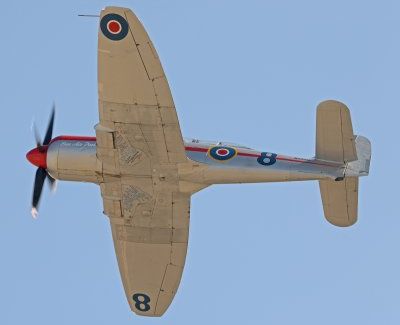 |
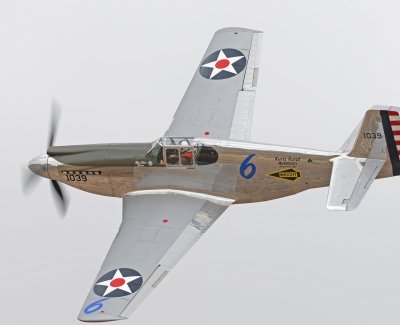 |
| View from below as Dreadnought, the R-4360 powered Sea Fury Mk T20, again piloted by Joel Swager, is seen just after takeoff while heading to form up for the start of Saturdays Gold Heat race. Dreadnought finished in first place, some 51 seconds ahead of second place Sea Fury Argonaut. | Dusty Dowd in his Allison powered P-51A Shanty Irish passing pylon 2 during Sunday’s Silver Final. Dusty won both the Friday and Sunday Silver races with speeds of 330.009 and 326.470 mph respectively. |
Thursday — Traditionally the fastest Gold Class Unlimited racers get the day off; this meant that Sea Furys Dreadnought, Argonaut, and #924G, along with the three Mustangs Wee Willy II, Blondie and Speedball Alice could stay in the pits and continue preparations for the hard running to come. As it turned out, wildfire smoke drifted in and the scheduled Silver heat was canceled for the day.
Friday — The eight Silver Class racers, all with inline engines, competed in the Silver heat at noon on Friday. This race was won by Shanty Irish, the P-51A piloted by owner John ‘Dusty’ Dowd at a speed of 330.009 mph, only four mph slower than the speed posted in the same heat the year before by P-51D Miss America, 333.937 mph. Dusty was followed closely by the returning Bardahl Special at 328.149 mph and Jeff LaVelle in Sweet and Lovely at 325.886 mph. They were followed closely by the rest of the field, where within there was some hearty racing amongst the competitors. Because of California wildfire smoke Friday’s afternoon’s Gold Heat was cancelled, a disappointment to all.
Saturday — By comparison with the rest of the week, Saturday was wonderfully clear, only occasional hints of haze on the horizon. This resulted in a very busy race day as the schedule was expanded to try and get in some of the previously postponed heats. Saturday’s Unlimited Gold Heat was moved to a morning race to take advantage of the then-good visibility and conditions. The six racers, three Sea Furys and three Merlin-powered P-51D Mustangs, started the six lap 47 mile heat at 10:21 am, hours earlier than what is usual. Their finishing order was no surprise with the Sea Furys, lead by Dreadnought, besting the Mustangs. Dreadnought only ran 415.732 mph (it had qualified at 431.150 mph), and still lapped all three Mustangs, while both Argonaut and #924G lapped last place P-51D Speedball Alice as well. It was fun to see all of the passing!
The six lap Silver heat was started in good visibility early in the afternoon. This again would be an all “in-line, liquid-cooled” event with eight racers, six P-51D Mustangs, along with the Allison powered P-51A and P-63C Kingcobra Pretty Polly. The race had P-51D Bardahl Special and P-51A Shanty Irish exchanging the lead with finishing speeds of 333.371 and 330.475 mph respectively. They were followed by Spam Can and Sweet & Lovely at 301.199 and 299.693 mph, who in turn were followed by Lady B and Man O’ War (294.877 and 294.662 mph respectively). These close “races” within the race are exciting to watch! With his Silver heat win in the Bardahl Special Steven Couches elected to “bump up” to the Gold for the scheduled Sunday Unlimited Gold Final. This left Shanty Irish to start the Sunday Silver on the pole.
Sunday — The day broke beautiful, and with little wind to worry the plans. It was to be a full day of racing with all of the classes seeking to name their Silver and Gold Winners. The first Unlimited race was the 54.9 mile, 7 lap, Silver Final scheduled for the early afternoon.
With Saturday’s Silver heat winner, the Bardahl Special, scheduled for the Gold Final there were six Mustangs and the Kingcobra for the Silver Final, an all in-line powered lineup. Unfortunately, Jeff LaVelle’s Sweet and Lovely was a “Did Not Start” so just six racers were on the course. Of these, Dusty Dowd in Shanty Irish took the lead in the P-51A and finished in first place at 326.470 mph. While he was not really challenged by any of the others, Spam Can, Man O’ War and Lady B had an exciting race just behind him, finishing within a span of just 12 seconds with speeds of 319.030, 314.249 and 312.731 mph respectively. The field was followed the Palm Springs Air Museum entries; Pat Nightingale in the P-63C Pretty Polly and Tom Nightingale in the P-51D Bunny at 295.342 and 293.725 mph.
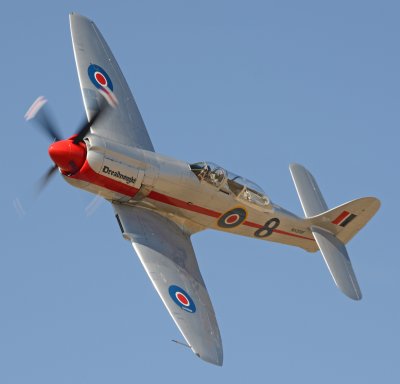 |
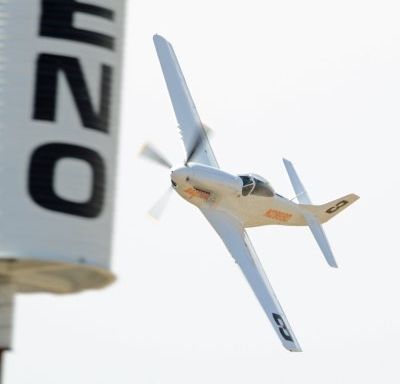 |
| Dreadnought again piloted by Joel Swager, coming around Pylon 2 Saturday morning. Joel went on to win the heat with a speed of 415.732 mph, a lot slower than his qualifying speed of 431.150 mph. Second place was taken by stablemate Sea Fury Argonaut, piloted by Mark Watt, at 368.931 mph. With the cancelation of Sunday’s Gold Final the results of the Saturday heat became the final Gold results. Joel has now won three Gold race wins while Dreadnaught has seven. | Here Steven Couches in the P-51D Bardahl Special passing pylon 2 during Saturday’s Silver heat race, which he won with a speed of 333.371 mph. |
Sunday’s Gold Final was being looked to for some racing excitement, even though Dreadnought was likely to be the overall winner, for the fifth time, its two stablemates, Sea Furies Argonaut and #924G, capable of speeds of about 375 mph, are very evenly matched and were expected to best the four P-51D Mustangs, all of which were capable of speeds well in excess of 330 mph, which was expected to provide some good racing behind Dreadnought. In the event, the tragic Jet accident in the heat preceding the Unlimited Gold Final resulted in event cancellation.
The Racers
The following descriptions of each airplane are given in the order in which they qualified. See the table at the end of this article for their speeds and placement in all of the Unlimited Heats.
#8 Dreadnought, a Hawker Sea Fury T.Mk.20, re-powered with a Pratt & Whitney R-4360-63A, rated for takeoff at 3,800 bhp at 2,800 rpm, and piloted again this year by Joel Swager, who had previously piloted Dreadnought to its 2018 and 2021 Gold Final wins. This big, handsome and heavy racer brings dependability to Unlimited racing — not having to push the engine to levels much beyond its original rating is beneficial, if you have enough power. Dreadnought is fast, having set a qualifying record at 452.737 mph back in 1986, though qualified this year at 431.150 mph.
#11 Miss America, a clipped wing P-51D was to be flown by owner Dr. Brent Hisey, had again been primed to be the racer to beat this year. Although Miss America was not an actual participant in this year’s races its story and the reasons why it didn’t make Reno, is relevant. Merlin engine builder Rick Shanholtzer had again gone through the racing Merlin and everyone believed it was in excellent condition when installed at Hisey’s Oklahoma home base. This engine uses the supercharger section from a V-1650-9, transport cylinder heads, with Merlin rods and makes 110 inHgA at 3,400 rpm while retaining the stock Merlin aftercooler. The Miss America team had also put additional work into the airplane to make it go even faster, with changes to the airframe, including a liquid-cooled P-51H oil cooler and the revised scoop/coolant radiator ductwork from Ridge Runner II, which is no longer racing.
As with most racers, there was a lot of work to do, and much of it came down to the last minute. The deadline requires being at the Stead airfield by noon on Saturday, before race week, which was September 10. Team Miss America began testing of the newly rebuilt and installed race engine on Friday, September 9! They did four engine runs totaling 3.5 to 4.0 hours at low power settings, followed by about 22 minutes at 50 inHgA and 2,400 rpm, and a final run of about the same length at 60 inHgA and 3,000 rpm. After each run the screens were pulled and inspected for metal, and in every case nothing unexpected was found. With this background they prepared for a test flight, and then the launch for Reno.
The test flight went well, taking off at 50 inHgA and 2,400 rpm and cruising at 40 inHgA and 2,400 rpm, returning after about 15 minutes. Everything was smooth, and Brent said there was plenty of power on tap. Following the flight Rick Shanholtzer again pulled the screens — and found metal! With only a day remaining, and all of the important tools and parts already on a truck midway to Reno, it was quickly determined that Miss America was out for Reno 2022.
When the crew began turning the prop over by hand they noticed a ‘clunking’ sound coming from the nosecase. This is far from normal and meant that the propeller needed to be removed for further inspection.
The race Merlin was then removed and sent to Rick Shanholtzer’s shop in Texas. There he went through every part of the engine, including the heads, blower, aftercooler, heat exchanger and nosecase. He found that the damage was totally confined to the nosecase, everything else was 100%. Within the nosecase he found that the bearing had spun! Furthermore, the nosecase bore was oversized and when flight loads were encountered it resulted in the damage to the nosecase. The repair involved sending it to Roush Aviation for them to add metal to the nosecase and rebore so a stock thrust bearing could be refitted. Current plans are to have the engine run-in on the test stand and re-installed before Christmas. Then after local shakedown flights, fly the airplane to Stead in time for June’s PRS, during which Brent plans to work up to some full-power laps. Then the aircraft will be “pickled” to await the September 2023 races.
#114 Argonaut, a Pratt & Whitney R-2800-CB3 powered single seat Sea Fury FB Mk.11 was flown by Mark Watt, qualifying at 377.097 mph, down from last year’s 383.704 mph. Mark finished in 2nd place during the only Gold race, which was flown on Saturday.
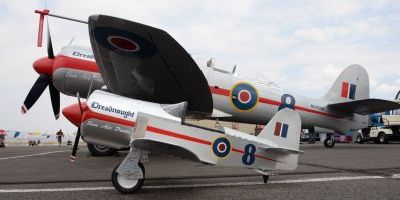 |
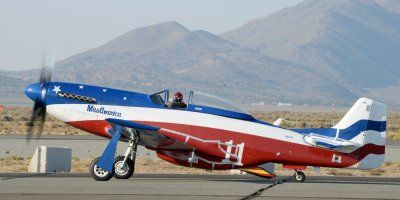 |
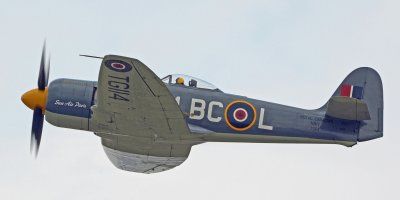 |
| Dreadnought and the Sanders peddle-plane Lil’ Dreadnought in the pits. Air racing is a family affair. | P-51D Miss America taxing out for takeoff during the National Championship Air Races, 2021. | Argonaut flown by Mark Watt during takeoff for his Qualifying run, where he posted the second fastest speed of 377.097 mph. In the only Unlimited Gold heat of the week he was also second, at 368.931 mph. |
#924G is a two-seat Sea Fury T.Mk.20, powered by its original, and rare, Bristol Centaurus 18-cylinder sleeve valve engine. This year it was flown by Bernie Vasquez, who qualified the racer at 354.430 mph. Last year Bernie piloted Goldfinger, a P-51D that did not participate this year. #924G finished 3rd in Saturday’s Gold heat as well.
#81 Wee Willy II, a stock P-51D from the Planes of Fame museum and flown by Robbie Patterson, who qualified at 338.908 mph, much improved over his 2021 qualifying speed of 317.196 mph. As Wee Willy II qualified 4th overall, he had the ‘Bye’ and only flew in the Saturday Gold heat, where he finished in 4th with a speed of 331.266 mph.
#44 Blondie, flown by Brant Seghetti, is another stock Rolls-Royce Merlin powered P-51D Mustang. Brant has been flying the aircraft at Reno since 1997, and qualified his racer this year at 331.808 mph. This placed him 5th in the qualifying lineup and into the Gold heat, thus receiving a Bye for Thursday. Brant finished the Saturday Gold heat in 5th position with a speed of 323.490 mph.
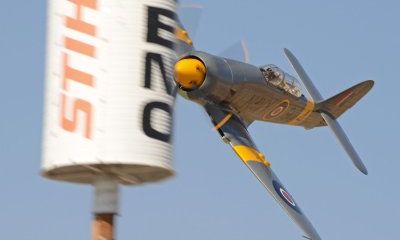 |
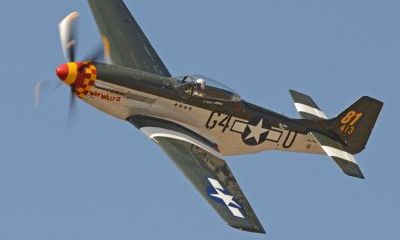 |
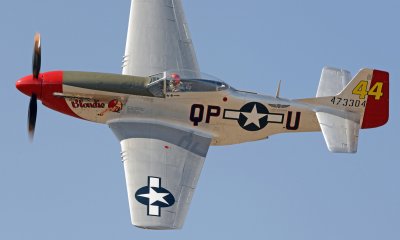 |
| It’s great to see, and hear, the big stock Bristol Centaurus powering a Sea Fury, a rare sight anymore. #924G was piloted by Bernie Vasquez this year, finishing third in the only Unlimited heat of the week, with a speed of 361.347 mph, ten seconds behind stablemate Argonaut. As you can see he ran the big bird low and close to the pylons on Saturday. | #81 Wee Willy II flown by Robbie Patterson, qualified at 338.908 mph, the fastest of the in-line powered racers. Here he is in the Saturday Gold heat where he finished as he qualified, in fourth with a speed of 331.266 mph. | #44 Blondie raced by Brant Seghetti ranked fifth in qualifying and finished the Saturday Gold heat in fifth as well. His speeds were 331.808 and 323.490 mph respectively. |
#31 Speedball Alice, another stock Merlin powered P-51D was qualified and raced by Dan Vance of Bend, Oregon. His qualifying speed this year was 295.255 mph, well down from his 2021 effort of 341.543 mph. He was the 6th overall in qualifying, which put him into the Gold heat competition.
#3 Bardahl Special, a stock Merlin powered P-51D qualified and raced by Steven Couches. His qualifying speed this year was 319.744 mph. He was the 7th overall in qualifying, placing him in the “Silver” division. This airplane has a long association with the Reno Air races, first appearing in 1964 as the Bardahl Special, owned by legendary Charles Lyford and piloted by Bob Love. Interestingly, the airplane, while having gone through several owners, still carries it first registration number, N2869D. For many years the airplane has appeared in stock form as “Section Eight.” For this year’s appearance the Section Eight markings were covered over by automotive type “film”, turning it into a replica of how it looked and raced back in the 1960s. Over the years it has carried a number of race numbers, including, Race #8, #3, #27 and this year, #3.
#3 finished 2nd in the Friday Silver heat, at 328.149 mph, and went on to win Saturday’s Silver heat with a speed of 333.371 mph, just besting Dusty Dowd in his P-51A Shanty Irish who finished at 330.009 mph.
#4 Sweet and Lovely, is also a stock P-51D, owned and flown by well known Sport Class champion Jeff LaVelle. Jeff qualified the airplane at a speed of 318.356 mph. In the Friday Silver heat race Jeff finished third with a speed of 325.886 mph, and in Saturday’s Silver heat finished fourth at 299.639 mph. Unfortunately, the Sport Gold Final, where he was to be on the pole, was scheduled so close to the Silver Final that he opted to skip the Sunday Silver Final.
 |
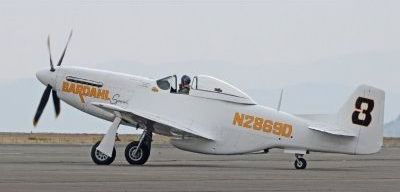 |
 |
| #31 Speedball Alice piloted by Dan Vance, is a stock Merlin powered P-51D. Seen here during Saturday’s Gold heat, where he posted a speed of 295.255 mph and finished sixth. He qualified at 329.886 mph and was evidently “saving” it for the next day’s Gold Final. | P-51D #3 Bardahl Special taxing out for his qualifying run on Monday. Pilot Steven Couches qualified with a speed of 319.744 mph. The racer is unique in having a film “wrap” over its entire exterior, replicating its appearance back in the 1964/5 races. | #4 Sweet and Lovely, a stock P-51D Mustang owned and piloted by the Sport Class pilot Jeff LaVelle. In 2021 he was the Unlimited Silver Final winner with a speed of 327.402 mph. This year he qualified at 318.356 mph, and then finished third in Friday’s Silver heat at 325.886 mph. On Saturday he posted a speed of 299.639 mph and then on Sunday was a Did Not Start. |
#0 Spam Can/Dolly, a stock P-51D from the Planes of Fame museum, again flown by Mark Moodie, who qualified at 314.570 mph. The airplane is “Dolly” on the port side and “Spam Can” on the starboard (“Spam Can was a nickname for the P-51 as it was made of thin metal skins, akin to “spam cans”). In the Friday Silver Heat Mark came in fourth with a speed of 307.884 mph, then on Saturday finished 3rd at 301.199, and on Sunday stepped it up to 319.030 mph and took second place.
#63 Pretty Polly was the forth Bell P-63A Kingcobra built and after spending the war doing test work for the NACA was surplused. The Palm Springs Air Museum restored the aircraft as a P-63C and it was again flown in the races by Patrick Nightingale. Originally the P-63s had a two-stage Allison V-1710-93 engine; however the auxiliary supercharger has been removed in Pretty Pollys current configuration. Patrick qualified the Kingcobra at 312.453 mph, a big step up from his 2021 qualifying speed of 294.693 mph. In Friday’s Silver Heat Pretty Polly finished fifth at 294.379 mph, then on Saturday went only 290.138 mph while finishing seventh, though on Sunday it was stepped up to 295.342 mph, finishing again in fifth.
#6 Shanty Irish is an early P-51A, powered by an Allison V-1710-111 (not original model) engine. The airframe was recovered from Alaska in the 1960s and ultimately restored as Polar Bear, which raced at Reno from 2005 through 2011. When Dusty Dowd acquired the airplane he found it was full of corrosion and then went through an expensive and tedious restoration to a true P-51A configuration; it has been racing as Shanty Irish since 2017. Dusty qualified the Allison powered Mustang at 310.811mph. On Friday he won the Silver Heat with a speed of 330.009 mph, and on Saturday came in second at 330.476 mph. He then went on to win the Silver Final on Sunday with a speed of 326.470 mph.
Dusty had a good week after getting off to a scary start. On Monday, while starting up for his qualifying run, a bad backfire resulted in a fuel fire under the cowling. Fortunately it was quickly extinguished and the damage was confined to some ignition and primer lines. New parts were obtained, repairs made, and he was able to qualify the next day.
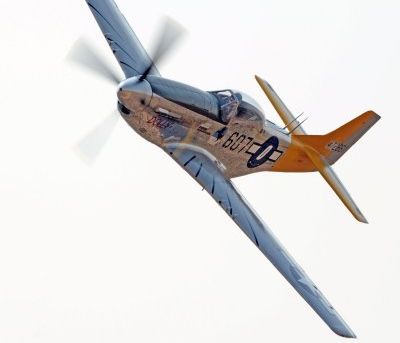 |
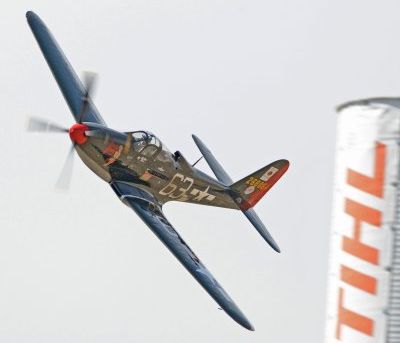 |
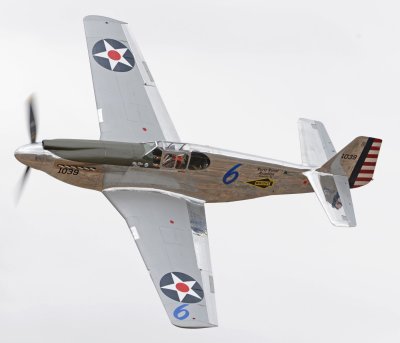 |
| #0 Spam Can/Dolly, a stock P-51D Mustang piloted by Mark Moodie, qualified at 314.570 mph shown here in the Friday Silver heat, in which he finished fourth at 307.884 mph. He stepped it up for the Sunday Silver Final and finished second running at 319.030 mph. | #63 Pretty Polly, a P-63C Kingcobra piloted by Patrick Nightingale, qualified at 312.453 mph shown here in the Saturday Silver heat, in which he finished seventh at 290.138 mph. He stepped it up for the Sunday Silver Final and finished fifth running at 295.342 mph. | #6 Shanty Irish, a rare and early Allison powered P-51A Mustang. Pilot Dusty Dowd qualified at 310.811 mph which put him in the Unlimited Silver class. He stepped it up out on the course and won the Silver Friday and Sunday races with speeds of 330.009 and 326.470 mph. Good enough to have been ceded into the Gold class if done during qualifying. |
#49 Lady B, a stock Merlin powered P-51D, was piloted by Michael Pfleger. He qualified at 296.287 mph, much slower than his 2021 speed of 311.013 mph. In the Silver heat race held Friday he finished sixth at 289.570 mph, then on Saturday finished in fifth at 294.877 mph. Sunday things got a bit more exciting and Michael finished in fourth with a speed of 312.731 mph, though in 2021 he took second place in the final at 317.043 mph.
This racer has a long and colorful history. E. D. Weiner raced it in the inaugural 1964 Reno event as #14, then in 1966 the number was changed #49 and it continued to race. In 1968 the color scheme was changed to an all-over yellow/black checkerboard. Lady B’s current scheme remembers the number, the checkerboard scheme and the original sponsor’s name of Bardahl Miss.
#62 Bunny, another stock Merlin powered P-51D came to Reno courtesy of the Palm Springs Air Museum. The airplane was qualified by Tom Nightingale at 289.241 mph and went on to finish 7th in the Silver Heat on Friday at 286.592 mph. In the Saturday Silver Heat he posted 281.674 mph, and finished in last place. For Sunday’s Silver Final Bunny stepped it up to 293.725 mph, which still left him in the sixth and final position.
#55 Man O’ War, a stock and very handsome Merlin powered P-51D came to Reno also sponsored by the Palm Springs Air Museum. The airplane was qualified and raced by Ken Gottschall, posting a qualifying speed of 276.327 mph, versus at 275.107 mph in 2021. Ken finished last in the Friday Silver heat at 280.640 mph, and stepped it up on Saturday to 294.662, which was sufficient for sixth place. For the Sunday Silver final Ken finished in third place with a speed of 314.249 mph, the best he had ever done.
#26 Rusin’ Thunder, the new R-2000 powered Yak U3 racer, which promised to be quite competitive, had unfortunately been disqualified following his qualifying effort earlier in the week for not properly following the course. Thus we don’t have a qualifying speed for comparing to the other racers.
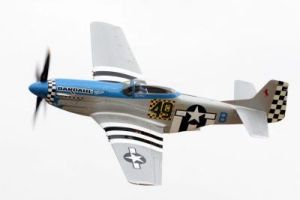 |
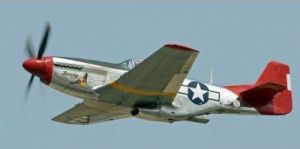 |
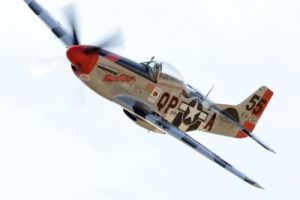 |
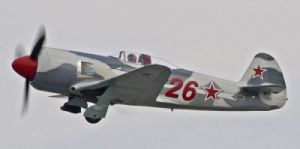 |
| #49 Lady B, a stock P-51D passing pylon 2 during the Sunday Silver Final. Pilot Michael Pfleger finished in fourth place with a speed of 312.731 mph. Note the “Bardahl Miss” applied to Lady B’s cowling, referring to its early racing career. | #62 Bunny, one of the racers from the Palm Springs Air Museum, following takeoff for its qualifying run. Tom Nightingale piloted the Mustang and qualified at 289.241 mph and ran in the three Silver heat races. During the Sunday Silver Final he ran 293.725 mph and finished sixth. | #55 Man O’War, a stock North American P-51D piloted by Ken Gottschall. Ken was the slowest of the qualifiers with a speed of 276.327 mph. In the heat races he finished eighth on Friday, sixth on Saturday and third on Sunday in the Silver Final with a speed of 314.249 mph. Picture taken on during the Saturday Silver Heat where Ken posted a speed of 294.662 mph. | New Silver Class Unlimited racer #26, a Pratt & Whitney R-2000 powered Yak named Rusin’ Thunder, taking off for his qualifying run on Monday. Pilot Scotty Crandlemire was denied a qualifying time for pylon cuts and was thus out for the week. All very unfortunate as the airplane has a number of racing enhancements, including ADI, which should make it a Gold class contender. |
The Airshow
Between races, and during some of the weather/smoke delays, the airshow part of the program was quite entertaining. All were done in front of the crowd where they keep their attention as we admired their skill. Remember, these performances are being done at a density altitude of over 6,000 feet.
Heritage Flight
The USAF Heritage Flight, featuring the F-22 Raptor which flew alongside its historic World War II-era counterpart, the P-51D Mustang, provided a display of the present and past, while demonstrating the advances in aviation performance accomplished over the past 70 years. The Mustang, Spam Can/Dolly, piloted by Stephen Hinton, Jr., seven-time Reno Unlimited Gold Champion (2009-2014 and 2016), was impressive to see while in close formation with the Raptor. For one thing, it pointed out the wide speed range capability of the Raptor, and the outstanding piloting of civilian Steven.
Prior to each airshow season the Heritage Flight aircraft and pilots train together at Davis-Monthan AFB. This year ten ex-military aircraft, five P-51Ds, two F-86s, and one each P-40N, P-38M, P-47G qualified to fly in shows with the currently operating high performance military aircraft. The airshow public gets a special treat when Heritage Flight aircraft are on the program.
Also on the Reno program was the US Navy Legacy Flight. It featured a performance by the F/A-18F Super Hornet followed by flying in formation with the Korean War Grumman F8F Bearcat, piloted by Steven’s father, Steve Hinton, who was named RARA Person of the Year for 2021, in recognition of his many aviation accomplishments, including having won multiple Reno Unlimited Gold Championships. On the last day’s performance Steve found it necessary to return to the field soon after takeoff due to a rough running engine. It was subsequently found that the Bearcat's R-2800 engine had a couple of bent push rods. Once these were replaced the airplane was ready for return to its home base.
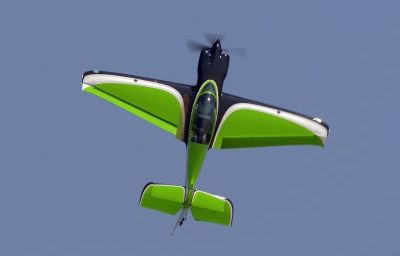 |
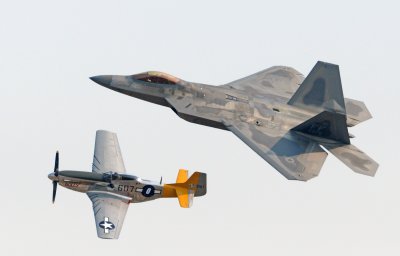 |
 |
| The Airshow includes a number of entertaining flyers, in a wide variety of aircraft. Here is an overhead pass/loop/roll by renowned aerobatic champion Philipp Steinbach in his certificated GB1 GameBird – Colorful and fun to watch, and a plane he designed himself. Notice the position of the controls, with the big ailerons, set for a rather quick counter-clockwise roll to the left! | P-51D Spam Can/Dolly, piloted by Stephen Hinton, Jr., leading the USAF F-22A in a fly-past at Reno 2022. When Stephen took off on Thursday for the Heritage Flight he soon radioed back reporting that visibility was unsuitable for the flight to perform – which was a precursor to cancelation of the afternoon’s racing. | Here’s a view of the USN Legacy Flight, with Steve Hinton Sr. leading in the Bearcat and the F/A-18F Super Hornet in close formation. It’s clear that today’s jets are a lot larger than WWII fighters! Interestingly, Steve’s Planes of Fame F8F-2 is still in the livery that it carried for the recent movie Devotion. |
The Other Racing Classes
While the primary focus of this article is on the Unlimited Division racers, there is a lot more racing going on! This includes the Jets, Sports Class, T-6s, Biplanes and Formula One as well as the STOL Drag Races. A brief description of the classes and some of the aircraft follows.
STOL Drag Racing
This relatively newly organized activity has now been on the Reno program since 2019. The event takes a traditional STOL (Short TakeOff/Landing) competition to the next level in that it is spectator friendly while challenging pilots and their skills. They fly a straight 2,000 foot course, down and back, with the competitors side by side. Winners are determined by who best manages power and energy coupled with a precision spot landing, all while in close proximity to the competitor.
This year there were 16 STOL Drag finishers, with Steve Henry in his #44 Yee-Haw, a Highlander, in first place. His Highlander has been fitted with a turbocharged Yamaha that turns an unbelievable 10,000 rpm! Last year’s champion, Toby Ashley in his highly modified Sarge, did not participate this year, thus the crowd did not get to see a faceoff between these two strong competitors.
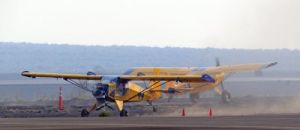 |
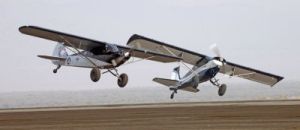 |
 |
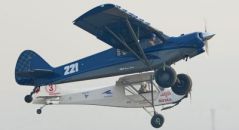 |
| Pilot Steve Henry in his STOL Drag #44 Yee Haw 6, a Just Aircraft Highlander, taking off for return while competitor #53 is still getting stopped. Yee Haw 6 is powered by a turbocharged Yamaha Jet Ski engine, turning some 10,000 rpm, and fitted with Nitrous Oxide, which interestingly, is sprayed into the aftercooler while the turbo spins down when the engine is powered down on the turnaround. This significantly helps increase power while the engine spins up for the return takeoff. Steve was the 2022 STOL Drag overall winner and posted a time of 59 seconds for the course. | Collin Caneva in his Carbon Cub #43 leads Bo Ellis flying his Legend Cub #80 in this Wednesday STOL Drag race. Overall, Bo Ellis finished 4th for the week and Collin was 11th. | STOL Drag competitor Eddie Sanches in #48 Devil Girl, a Just Aircraft Highlander, slipping in for a quick landing during the competition. | STOL Drag racing is very intense and close! Here Brian Steck in #221 Scooter, his American Legend MOAC (Mother of All Cubs), is just a nose ahead of #3 Harold Stockman in his Rotax powered RANS S-7S Courier Lawn Mower III. |
Jet Class Racing
The Jet class is the fastest of the racers, with this year’s qualifying speeds ranging from 512.039 mph down to 360.836 mph. This speed was likely a major factor in the tragic loss of race pilot Aaron Hogue and his Aero Vodochody L-29 Super Delfin Ballista during the third lap of the Sunday Jet Gold Final. While the final analysis and accident report has yet to be published, the NTSB Preliminary Report notes that between pylons 4 and 5 the pilot initiated an unusual right hand turn, then rolled into a slight climb on the outside of the track, reversed left while attempting to reenter the race. This began a continuous descent and contact with the desert floor. They speculate that the pilot may have experienced G-induced loss of consciousness (G-LOC), a consequence of the high g-loads likely induced by the high speed maneuver.
The 18 jets in this year’s class were all built by the Czechoslovakian firm Aero Vodochody and comprised eight L-29 Delfins and ten L-39 Albatros. The high performance Super Delfin utilizes a 3,000 pound thrust Pratt & Whitney J60/JT-12-6 in place of the original 1,960 lbf Motorlet M-701C-500. This FAA approved change meets the Reno rules requirement that the engines not be modified and must be operated in accordance with the original manufacturer’s instructions. The result is quite a hot rod and a very competitive racer as the Super Delfin is 100 knots faster that the stock Delfin, and 50 knots faster than the stock L-39.
 |
 |
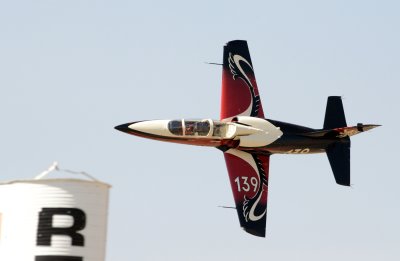 |
| During Friday’s Jet Heat are #29 and #77, two Aero Vodochody L-29 Super Delfins racing for the lead. Aaron Hogue in #29 Ballista won at 487.150 mph, edging Peter Stavrides in #77 Viper, who finished with a speed of 487.145 mph. They qualified at 512.039 and 509.216 mph respectively. | Jet Class racers #11 Ivan, an L-39C flown by Jerry Kerby, being passed on the outside by the Czechoslovakian manufacturered Aero Vodochody L-39MC #7 Red Thunder, piloted by Alex Eckmann of Rio de Janeiro, Brazil. Alex finished second, at 443.034 mph, in the Friday heat while Jerry finished fourth at 422.894 mph. The race was won by Vicky Benzing in her L-39C Robin 1 at 447.520 mph. | Dianna Stanger comes by Pylon 8 on Saturday in her Aero Vodochody L-139, Dark Star. Race #139, an L-39 re-engined with a Garrett TFE731 turbofan, producing 4,080 lbf (18.15 kN) thrust in place of the standard Soviet-built 3,790 lbf (16.87 kN) Progress AI-25TL turbofan. She finished 3rd with a speed of 427.762 mph. |
Sport Class Racing
The Sport Class Division fielded 29 qualifying competitors with speeds ranging from 202.870 to 402.491 mph, the result of the wide variety of airplanes, including Van’s RV-4s, RV-8s, Glasair IIIs, Thunder Mustangs and Lancairs. Racers may be any kit or amateur built airplane certificated by the FAA and capable of at least 200 mph. There were lots of power options — including turbosuperchargers, ADI and Nitro, as well as many naturally aspirated engines, with all having displacements less than the 1,000 in³.
This division provided some of the most exciting moments, including very close racing and also a few “May-Day’s.” Sunday’s Sport Gold Final is most demonstrative! Three airplanes “Did Not Finish,” including Andrew Finlay in his Lancair Legacy #30 on lap one, and then #24 Jim Rust in his Glasair III Gremlin’s Castle, followed by AEHS contributor Jeff LaVelle in his Glasair III #39. These three turbosupercharged racers were the class of the field, and having them drop out 1 — 2 — 3 changed the Gold Final!
A number of the Sport Class racers are operating as “unlimiteds,” that is with combinations of turbos, Nitros, ADI and other “tricks” to go really fast. As a result, engine problems are rather frequent. For example, Jim Rust’s turbosuperchargedGlasair III, Race 24, stuck a piston on the number six cylinder during qualifying and made a successful emergency landing. The fix was to have Ly-Con overnight a new cylinder/piston and then get back into the fray. Even getting to Reno can be troublesome, as Andrew Findlay’s One Moment, a turbosuperchargedLancair Legacy, Race #30, found when he had turbo problems before he even got to Reno. These persisted during the week, first during the Saturday Gold race when he had to pull out after lap 1 with an overheating #6 cylinder, found to be due to a clogged cylinder cooling water spray fitting; this required a cylinder change. During the Sunday Gold Final., he had hoped that the new cylinder and rings would “seat” while on the form-up and first lap; however, he had to pull out on the Sport Gold Final first lap, another DNF. The favorite to win the Sport Gold Final was Jeff LaVelle in his Glasair III, Race 39. He had qualified at 402.491 mph and won the Saturday heat race at 395.899 mph; then in the Sunday Final a turbo waste-gate came loose and bypassed so much exhaust gas that he couldn’t maintain manifold pressure. As this was going on his ADI flow became excessive for the amount of air going into the engine and drowned the engine, putting the “fire” out. He successfully May-Day’d early in lap 4. After repairing the waste-gate he successfully flew his racer home a week later.
With the top ceded Sport racers all out by the end of lap 4 the win went to Mathias Haid, of Salzburg, Austria, in the Falconer V-12 powered Clas Thunder Mustang, who posted a speed of 333.199 mph for the six lap final.
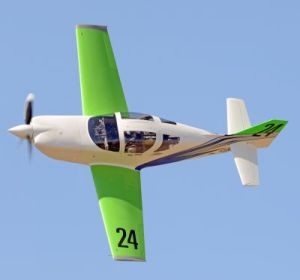 |
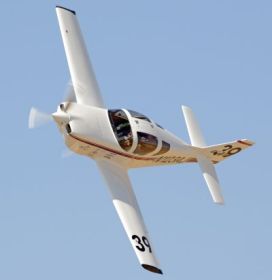 |
 |
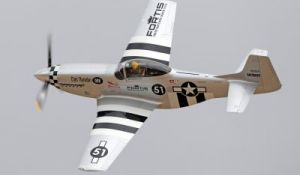 |
| “SPORT” Class racers #24 and #39 during Saturday’s Gold heat race. Both are turbosupercharged Glasair IIIs, flown by Jim Rust and Jeff LaVelle respectively. Jeff qualified first overall at 402.491 mph and won the Saturday heat at 395.899 mph, with Jim in second at 357.797 mph. | Left is Andrew Findlay in his turbosupercharged Lancair Legacy #30, One Moment, on the first lap of the Sunday Sport Gold Final going around pylon 2, just moments before he had to May-Day out due to a broken engine and successful emergency landing. The #51 Clas Thunder three-quarter scale Thunder Mustang, piloted by Mathias Haid of Salzburg, Austria, went on to win the Sport Final with a speed of 333.199 mph. He was running a back-up Falconer V-12 as his race engine developed a coolant leak due to a cracked cylinder early in the week. | ||
T-6 Class Racing
Sixteen T-6/SNJ racers qualified for this year’s competition, up from twelve last year. Their speeds ranged from 236.590 to 190.229 mph. During the week there were six heats for the T-6 Class as several of the planned heats had to be canceled due to the heavy wildfire smoke in the area. Still there was a lot of good close racing.
The T-6 Class is for “stock” airplanes. Other than airframe and engine “clean-up” not much can be done. Engines are the original 600 HP Pratt & Whitney R-1340, with standard compression ratios, but tuned to run a little faster.
Chris Rushing in #14 Baron’s Revenge, an AT-6B, qualified first at 236.590 mph and took the Gold Final on Sunday with a speed of 240.213 mph. This made his third overall win in a row and was his fourth win in the last six years of racing.
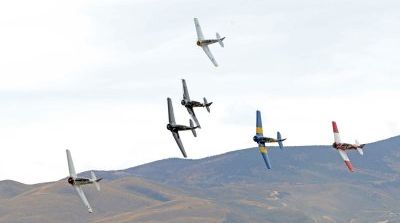 |
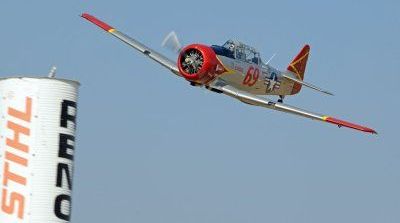 |
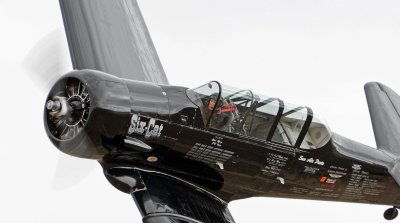 |
| Here is the field of six T-6s at the start of the Sunday T-6 Gold Final. Close racing was the order of the day. The final was won by Chris Rushing in #14 Barons Revenge at 240.213 mph. This pack stayed close together through the whole race with the last two airplanes posting 223.69 and 223.230 mph. Always fun to watch the T-6s race. | Lee Orman in his AT-6D Eros during Saturday’s heat race, these guys get really close to the pylons. He finished with a speed of 191.775 mph. | T-6 racing is intense – Nick Macy in his SNJ-5 Six Cat who finished second in the Sunday Gold Final with a speed of 232.251 mph. |
Biplane Class Racing
Fifteen Biplane racers qualified this year with speeds ranging from Sam Smith in his Smokin’ Hot Pitts S-1S at 206.988 mph down to 146.426 mph. Biplanes must have a minimum dry weight of 500 pounds; at least 30% of the required 75 square foot wing area must be in the smaller of the two wings. They cannot have retractable landing gear and must have a fixed pitch propeller. The largest engine permitted is the four-cylinder Lycoming 180 hp O-360 .
 |
 |
 |
| Bi-Plane Class fastest qualifier, and winner of the Gold Final, was Sam Smith in his Pitts S-1S #3 Smokin’ Hot. He qualified at 206.988 mph and posted a Final winning speed of 205.784 mph. | Dave Holmgren in his #6 Pitts S-1S Miss Dianne staying ahead of Alan Hoover in #84 Panther on his way to winning the Sunday Silver Final. They stayed close – their final speeds were 180.962 and 180.917 mph respectively. | Scott Prewitt in his #314 Pitts S-1C Flip Flop during the Saturday heat race where he finished last in the seven plane race with a speed of 169.825 mph. Sam Smith in #3 Smokin’ Hot won the heat with a speed of 198.569 mph. |
Formula One Class Racing
Formula One Class racing was introduced at the Cleveland Air Races in 1947 with the intent to enable pilots to design, build and race their own planes at an affordable price. As a result, it is a very popular class of air racing with many very competitive entries. There are several other F1 races across the country and around the world each year: The Reno National Championship Air Races provides their biggest purse. The ruling requirements are that they must have a minimum dry weight of 500 pounds, non-retractable landing gear, a minimum wing area of 66 ft² and a fixed-pitch wood or composite material propeller. Engines are the four-cylinder Continental O-200, nominally rated at 100 HP at 2,750 rpm, however by “blue printing” and balancing the engine, installing a short propeller, pitched to allow 4,000 rpm, they produce more like 150 HP and achieve speeds in the range of 250-270 mph.
Thirteen Formula One racers qualified this year, led by Steve Temple in Fraed Naught, a Gilbert DG-2 that posted a speed of 249.013 mph. The slowest qualifier was J.P. O’Dell in Monkey Ninja, a Cassutt 111-M with a speed of 174.802 mph. Ten of the racers were Cassutts, an attractive, and fast, airplane that has been raced since 1954. The other three were Fraed Naught, a Gilbert DG-2, Limitless, a SnoShoo SR1, and No Strings Attached a Shoestring.
 |
 |
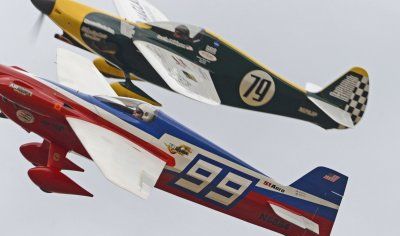 |
| #74 Phat Ass Cass, a Cassutt 111-M flown by Shaun Milke of Fairbanks, Alaska, qualified next to last at 181.152 mph, but is shown here during Friday’s Heat race to emphasize just how close and personal the Formula One racers are to the pylons and photographers. Shaun finished 3rd in this race with a speed of 184.115 mph. | For the fourth time Gilbert DG-2 #31 Fraed Naught was the fastest Formula One qualifier, at 249.013 mph, but this was the first time piloted by Steve Temple. Here Steve is on his way to a 2nd place finish, at 232.150 mph (which included a 16 second penalty for a pylon cut) in the Formula One Gold Final, won by the SnoShoo SR1 Limitless with a speed of 242.444 mph. | Close racing during the Sunday Gold Formula One Final between Cassutt 111-M, #99, What Airplane Honey? and the Shoestring #79 No Strings Attached. They finished 3rd and 4th respectively with speeds of 219.529 and 217.893 mph. |
Summary
The tragic loss of the jet racer overshadows much of the joy thousands of race fans shared during the week. Still one has to admire the skill and courage of the racers, crews, owners, volunteers and supporting families that it takes to put on an event such as this. It is a well done and professionally operated event. The wildfire smoke cut into the race program, but even so, a lot of good, safe and exciting racing occurred during the week. I hope that you were able to pick up on some of it through this report.
See you all at Reno 2023!
| Race No. | Name | Aircraft Type | Pilot | Qualifying mph |
Thursday mph |
Friday mph |
Saturday mph |
Sunday mph |
|---|---|---|---|---|---|---|---|---|
| 8 | Dreadnought | Hawker TMK20 Sea Fury/R-4360 | Swager, Joel | 431.150 | BYE | Canx-Smoke | 415.732G1 | Race Canx¹ |
| 114 | Argonaut | Hawker Mk 11 Sea Fury/R-2800 | Watt, Mark | 377.097 | BYE | Canx-Smoke | 368.931G2 | Race Canx¹ |
| 924 | #924G | Hawker TMK20 Sea Fury/Centaurus |
Vasquez, Bernie | 354.430 | BYE | Canx-Smoke | 361.347G3 | Race Canx¹ |
| 81 | Wee Willy II | F-51D Mustang | Patterson, Robbie | 338.908 | BYE | Canx-Smoke | 331.266G4 | Race Canx¹ |
| 44 | Blondie | P-51D Mustang | Seghetti, Brant | 331.808 | BYE | Canx-Smoke | 323.490G5 | Race Canx¹ |
| 31 | Speedball Alice | P-51D Mustang | Vance, Dan | 329.886 | BYE | Canx-Smoke | 295.255G6 | Race Canx¹ |
| 3 | Bardahl Special | P-51D Mustang | Couches, Steven | 319.744 | Canx-Smoke | 328.149S2 | 333.371S1 | Race Canx¹ |
| 4 | Sweet and Lovely | P-51D Mustang | LaVelle, Jeff | 318.356 | Canx-Smoke | 325.886S3 | 299.639S4 | DNS-Silver |
| 0 | Dolly/Spam Can | P-51D Mustang | Moodie, Mark | 314.570 | Canx-Smoke | 307.884S4 | 301.199S3 | 319.030S2 |
| 63 | Pretty Polly | P-63C Kingcobra | Nightingale, Patrick | 312.453 | Canx-Smoke | 294.379S5 | 290.138S7 | 295.342S5 |
| 6 | Shanty Irish | P-51A Mustang | Dowd, Dusty | 310.811 | Canx-Smoke | 330.009S1 | 330.476S2 | 326.470S1 |
| 41 | Lady B | P-51D Mustang | Pfleger, Michael | 296.287 | Canx-Smoke | 289.570S6 | 294.877S5 | 312.731S4 |
| 62 | Bunny | P-51D Mustang | Nightingale, Tom | 289.241 | Canx-Smoke | 286.593S7 | 281.674S8 | 293.725S6 |
| 55 | Man O’ War | P-51D Mustang | Gottschall, Ken | 276.327 | Canx-Smoke | 280.640S8 | 294.662S6 | 314.249S3 |
| 26 | Rusin’ Thunder | Yakovlev Yak 11/R-2000 | Crandlemire, Scotty | DNQ | DNR | DNR | DNR | DNR |
| S = Silver Heat Race, G = Gold Heat Race, DNS = Did Not Start, DNF-# = Did Not Finish-lap out, DNQ = Did Not Qualify, DNR = Did Not Race, DQ = Disqualified, BOLD = 1st Place Heat Winners, Number following Heat letter is finishing position ¹ Race Canceled due to Jet Accident | ||||||||
Send mail to
![]() with questions or comments about this web site.
with questions or comments about this web site.